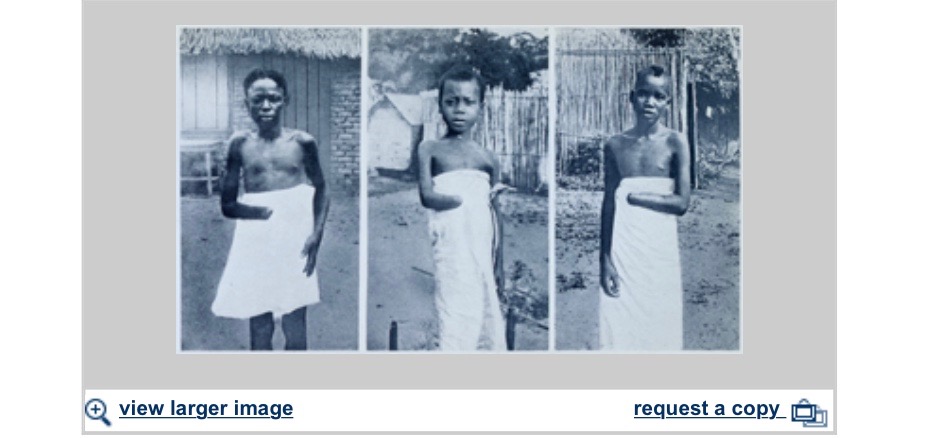
Both the text “Oroonoko’ by Aphra Behn and “Mutilated children, Congo” which can be found at the New York Library: Schomburgh center for research, represents a form of punishment throughout the slavery time period. After analyzing both pieces it is in fact evident that slavery was worse than death. This wasn’t the life they sought for but, they weren’t afraid to die. They were also used as an example to the other slaves, as what not to do or you will also deal with the same consequences. Amongst both of these pieces you can determine that the slave owners held the power. The power was they could do whatever they pleased to the slaves even remove limbs. At the end of the day the slaves still remained slaves. Throughout their brutal lifestyles and hardships, they still remained a slave even once they were dead and gone.
There’s a photograph that was collected from an article that was published in the Boston Herald, Nov 6, 1905. There are three young boys Ikabo, Lokota, Epondo. The three boys appeared to be young children. Each boy received harsh punishment from the Belgians. The boys were punished for not meeting their quota of their daily rubber collecting. The boys are bare skinned with only a sheet or towel wrapped around their waist. Also present in the photograph: a shack along with dirt indicating these young men were outside. The story that the photo is showing is that they were taught a lesson for not succeeding at the task but, they were also used as an example to others. Their pictures were taken as a hall of fame to teach others a lesson that this too can happen to you. If you do not do as your told there would be brutal consequences. Likewise, we also saw the harsh and grotesque punishment and killing of slaves in the protagonist “Oroonoko” by Aphra Behn.
Presented in “Oroonoko” the same grotesque brutality is displayed. We first see it with the death of Imoinda, Caesar’s wife. Imoinda seeked to be sent to her own country (the next world). She begun “And on her knees, besought him, not to leave her a prey to his enemies” (page 61). It also was a wife’s respect to their husband to die by their hand. If not she can be sold or even killed by someone else. She put forth the effort “The lovely, young, and ador’d victim lays her self down, before the sacrifice” (page 61). Caesar did the honors by laying his pregnant wife to rest. First he cut her throat, then placed her body on the leaves and flowers which made a bed. He covered everything but her face. Caesar made an attempt to kill himself once he was discovered after killing his wife. The question was “Who will kill venture this single man? Will nobody?”. Caesar replied “fatal will be be the attempt to the first adventurer; let him assure himself” (page 62). Caesar had no fear to inform them “Tis not life I seek, nor am I afraid of dying” (page 62-63). Cutting a piece of flesh from his own throat, proving to them he’s not afraid of ending his life. Caesar’s death was more hostile. Caesar was informed he would die like a dog. They allowed him to smoke his last pipe while he was tied up. First the executioner cut off his members and threw them into the fire. Second with an ill-favored knife they removed his ears and nose and those too were placed into the fire. Last but not least his arms were individually removed. It wasn’t until the removal of the last arm his head sunk and the pipe left his mouth. He gave up the ghost. The execution of Caesar was used as a warning. They also cut up his body and sent it to several of the chief’s plantations.
A recurring theme that’s being represented in both “Oroonoko” and “Mutilated children, Congo” is slaves were dehumanization and worthlessness to the slave owners. Some lingering questions I have is: Who determined what the cruel punishment should’ve been? As far as the mutilated children how many limbs did they have to lose before deciding if death or to be sold was their next option? Were they ever given the chance to have a different job if the first placement wasn’t working out?
Work citied
1.Behn, Aphra. Oroonko. First Melville House Printing. August 2014.
- Schomburg Center for Research in Black Culture, General Research and Reference Division, Edmund Dene Morel, King Leopold’s Rule in Africa (New York: Funk and Wagnalls, 1905)

